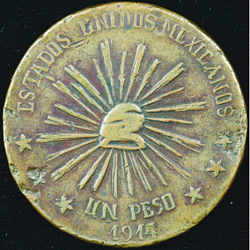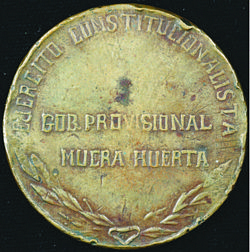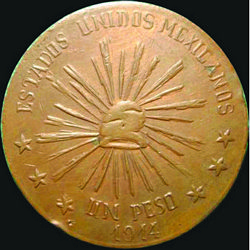Known examples of the early ‘Muera Huerta’ pattern
by Angel Smith Herrera
This short article is intended to invite collectors of certain areas to conduct research on particular specimens which can be easily traced due to both their scarcity and distinctive features.
I believe that a common misconception (at least for collectors that are new to the hobby) is that because a coin is plated in a book or catalog it is readily available. Experienced collectors will know that even on “easier” series such as Mexican 20th century coinage many coins are hard to find either by year or in some cases when looking for top condition: thus part of the learning process of each collector/numismatist will deal with the availability of a particular coin.
Fortunately, when collecting certain areas of Mexican numismatics, such as, for example, the revolutionary period from 1913 to 1917, certain specimens can even be traced by looking at their plates in books and auction catalogs because they have particular features that make them easily identifiable. To give just one example we may look at GB-195 (Guerrero silver $1, 1914) which is believed to be the only one known with a plain edge and struck with such a die combination. This coin has appeared plated in the standard reference and auction catalogs through the years and identification is extremely easy due to the double strike it has.
The plate matching process mentioned above can be used on certain scarce to rare coins and the result would be to get a pretty close idea about their true rarity. Further, one may trace a particular coin to a famous collection or collector giving it a provenance. Of course it would remain practically impossible to learn about every private sale or obtain each and every auction catalog dealing with Mexican coinage but the results (when relying on a decent library) should be quite accurate.
Below you will find information compiled on the “granddaddy” of a very popular issue from the Mexican revolutionary period, the “Muera Huerta” Peso. This coin, listed in Guthrie and Bothamley Hugh Guthrie with Merrill Bothamley, Mexican Revolutionary Coinage 1913-1917, Superior Stamp & Coin Co., Inc., Beverly Hills, 1976 as GB-81, is believed by many to be a pattern for the famous Muera Huerta issue. This may very well be true since the coin is very hard to find and is known only in copper. It is easy to assume that the design was not approved since the final product (mass produced) has a quite different design including the national eagle. Due to the very limited number of surviving examples and the differences in the grades they have, it is easy to trace a particular coin through the years. Following is the result of such research:
GB-81 population list and related data
“OSTHEIMER-ROZA-BOTHAMLEY” specimen (Utberg plate coin).
Listed by Neil S. Utberg in his The Coins of the Mexican Revolution 1910-1917Neil S.Utberg, The Coins of the Mexican Revolution 1910-1917, Edinberg, TX., 1965. as “U-DUR-1a” as belonging to the Ostheimer collection. Mexican Revolutionary Coinage 1913-1917 (by Hugh S. Guthrie and Merrill Bothamley, 1976) plate coin listed in their price list at $2,500.00 Fine, $3,000.00 Very Fine, $3,500.00 Extra Fine.
This specimen was auctioned by: (i) Superior Stamp & Coin Co., Inc. in the June 1976 C.O.I.N. Sale, Lot # 3193 price realized $7,250.00; (ii) Superior Stamp & Coin Co., Inc. (Muñoz sale), Lot # 479 realized $3,000.00.
This same coin was used as plate for Almanzar’s checklist from 1979 Alcedo Almanzar, Mexican Revolutionary Coins. (Checklist and Price guide), San Antonio, TX., 1979: interestingly Almanzar catalogues as his “RA-129a” a similar piece but struck on a lead piedfort but with legend “PROVICIONAL“ instead of “PROVISIONAL” which he considers to be unique. Also it is the plate coin for Frank W. Grove’s Coins of Mexico listed as his # 7782, with a size of 39mm.
“BUTTREY-GAYTAN” specimen.
Carlos Gaytan lists in his La Revolución Mexicana y sus MonedasCarlos Gaytan, La Revolución Mexicana y sus Monedas, México, D.F. Reprint 1971 as his “DGO-2” and provides picture of a specimen which was submitted by Dr. Theodore Buttrey. I have not seen this specimen at auction. It appears that this particular specimen was donated to the American Numismatic Society.
“KARAM” specimen.


Auctioned by Richard A. Long Sale # 95, Lot # 443, 16 October 1995. Described as “Very fine detail but several digs, marks, and rim nicks”; price realized $1,800.00 plus 10% commission on an estimate of $3,000.00-$4,000.00. Auctioned in February 1999 by Ponterio & Associates Sale # 98, Lot #746: price realized $3,520.00. Weight of this particular piece is 22.80 grams. Sale by private treaty in 2009 for $5,500.00.
“PONTERIO” specimen.
Auctioned by Ponterio & Associates Sale # 77, Lot # 110 on 7 October 1995. Graded “Surface marks, Very Fine”; realized $3,000.00 plus 10% buyer’s fees.
“TEXAS” specimen.


A specimen that appears to be previously unreported (plated). I heard rumors several years ago about a specimen being offered for sale in Texas but never got to see it. This one turned up at El Paso and I was able to record its information. Of course it does not match any of the plates of the previously listed coins. Weight of this particular piece is 22.73 grams.
As you will see, through the years we can identify five different specimens of this particular coin; not many taking into account the wide number of collectors of this era.
Addendum

Pattern struck in lead (Stack's Bowers & Ponterio Baltimore Auction, 16 November 2012, lot 11434)
A pattern struck in lead with four edge bumos, a couple of edge nicks and some surface marks. Sold for $2,600 at Stack's Bowers & Ponterio November 2012Baltimore Auction.
